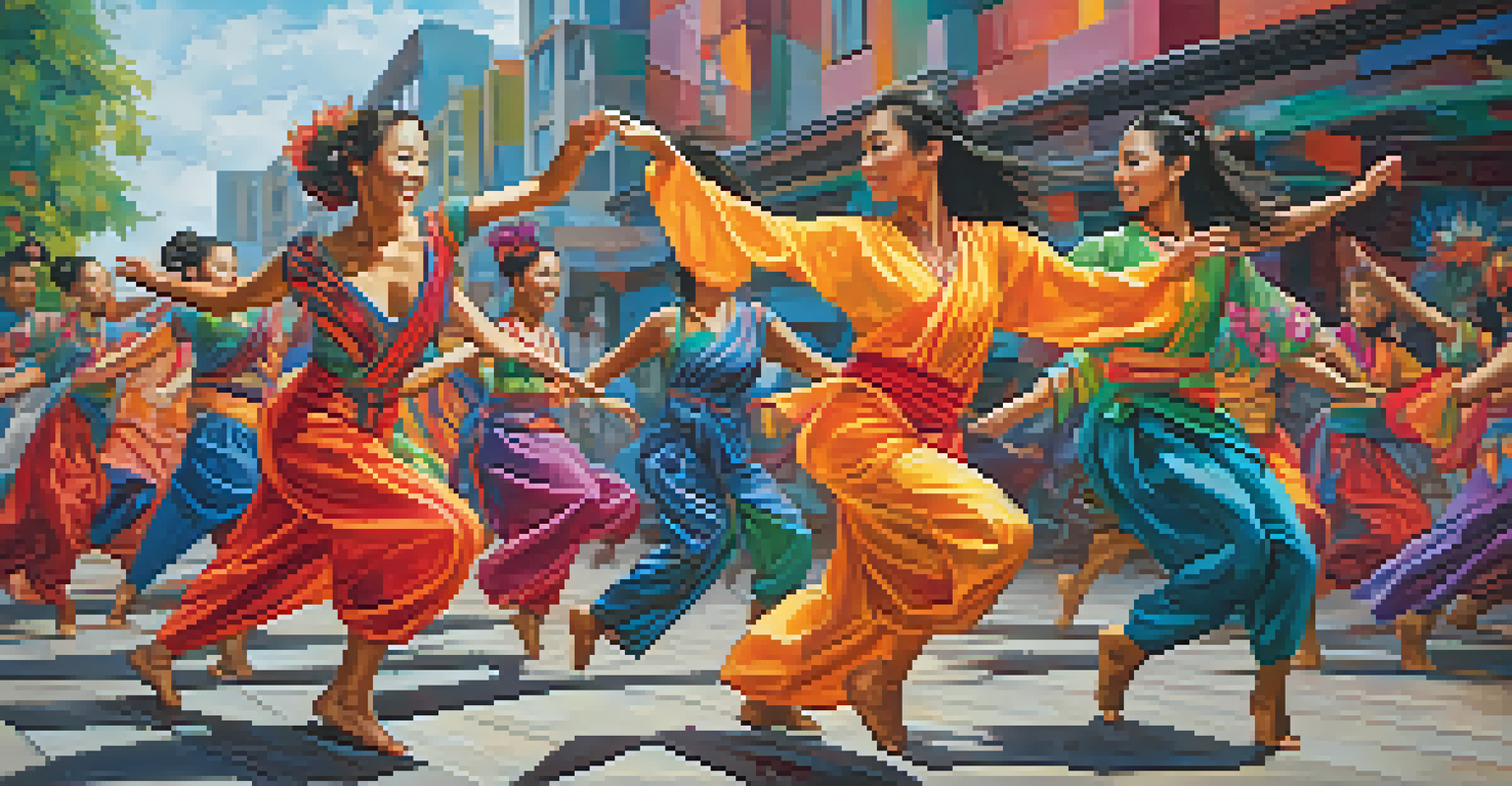The Impact of Asian Music Genres on Western Pop Culture

The Globalization of Music: A Cultural Exchange
In recent years, music has become a powerful vehicle for cultural exchange, breaking down geographical barriers. With the rise of the internet and social media, genres like K-pop and J-pop have transcended their origins, captivating audiences worldwide. This phenomenon highlights how music can foster understanding and appreciation across cultures, creating a rich tapestry of sound that is accessible to all.
Music is the universal language of mankind.
For instance, the explosive popularity of BTS, a South Korean boy band, showcases how Asian music genres are not just niche but are now mainstream. Their catchy songs, combined with mesmerizing choreography, have won over millions of fans globally and sparked interest in the Korean language and culture. This indicates a broader trend where Western audiences are not only consuming but also engaging with Asian musical styles.
Moreover, this cultural exchange is a two-way street. Western artists are increasingly incorporating Asian elements into their work, leading to innovative hybrids that reflect a shared musical language. Such collaborations enrich the global music landscape, allowing for creativity that resonates with diverse audiences.
K-Pop: A Case Study in Cultural Influence
K-pop stands out as a prime example of how Asian music has impacted Western pop culture. With its vibrant visuals, addictive hooks, and elaborate performances, K-pop has redefined what it means to be a pop star. Groups like BLACKPINK and EXO have not only topped charts but have also become global fashion icons, influencing trends far beyond music.

The success of K-pop in the West has prompted a surge in interest in Korean culture, language, and even fashion. This phenomenon is evident in the way many fans engage with Korean dramas and movies, showcasing a holistic approach to cultural consumption. It’s not just about the music; it’s about embracing a whole lifestyle that K-pop embodies.
Asian Music's Global Impact
Genres like K-pop and J-pop have transcended their origins, captivating worldwide audiences and fostering cultural exchange.
Furthermore, K-pop's strategic use of social media platforms like TikTok and YouTube has amplified its reach, allowing fans to interact with their favorite idols and share their own content. This direct engagement creates a community that transcends borders, fostering a sense of belonging among fans globally.
J-Pop and Its Subtle Influences on Western Music
While K-pop may dominate headlines, J-pop has quietly made its mark on Western music, especially through anime soundtracks and collaborations. Artists like Utada Hikaru and Kenshi Yonezu have gained recognition in the West, influencing musicians across genres. The distinct sound and storytelling in J-pop can be seen in the works of Western artists who draw inspiration from its unique melodies and themes.
The beauty of music is that it transcends language, culture, and time.
For example, the incorporation of J-pop elements into tracks by artists like Pharrell Williams or Ariana Grande highlights the genre's growing appeal. These artists often experiment with different musical styles, showcasing a blend that resonates with diverse audiences. This cross-pollination of sounds enriches the Western music scene and introduces listeners to new cultural dimensions.
Additionally, the rise of anime culture has brought J-pop to the forefront, with many fans seeking out Japanese artists after watching their favorite shows. This connection between anime and music creates a unique bond, encouraging Western fans to explore the broader spectrum of Japanese entertainment and its cultural significance.
Chinese Music: A Growing Presence in Pop Culture
Chinese music, particularly through genres like Mandopop, is increasingly influencing Western pop culture. Artists such as Jay Chou and G.E.M. have gained international recognition, bridging the gap between Eastern and Western musical styles. The melodic structures and lyrical themes found in Chinese music offer fresh perspectives that resonate with global audiences.
Moreover, collaborations between Western and Chinese artists are becoming more common, further solidifying this cultural exchange. For instance, American rapper and singer-songwriter, Lil Pump, collaborated with Chinese artist, Jony J, showcasing how diverse sounds can merge to create something innovative. These partnerships not only amplify the reach of Chinese music but also highlight the growing interest in China's rich musical heritage.
Cultural Fusion in Pop Music
Collaborations between Western and Asian artists are blending musical styles, enriching the global music landscape.
As the global music landscape becomes more interconnected, it's essential to recognize the significance of Chinese music in shaping current trends. This growing presence encourages open-mindedness and appreciation for the diversity of music, allowing listeners to expand their horizons.
The Influence of Asian Instruments and Sounds
One of the most fascinating aspects of Asian music is its unique instruments and sounds that have begun to find their way into Western pop music. Instruments like the erhu (a two-stringed instrument) and the tabla (a pair of hand-played drums) add a rich texture that enhances the musical experience. Western artists are now experimenting with these sounds, creating a fusion that captivates listeners.
For instance, the recent trend of using traditional Asian instruments in pop songs not only introduces new auditory experiences but also pays homage to the cultures they originate from. Artists like M.I.A. have incorporated sounds from various Asian genres, showcasing how diverse influences can coexist harmoniously in a single track. This blend encourages appreciation for the intricacies of different musical traditions.
Additionally, the rise of world music festivals has provided a platform for these unique sounds to be celebrated. Events like the Global Music Festival bring together artists from different backgrounds, allowing them to collaborate and share their cultural heritages. As audiences become more exposed to these sounds, it fosters a greater understanding of the world’s musical diversity.
Dance Trends: From Asia to the West
Dance has always been an integral part of music, and Asian music genres have introduced exciting new trends that have made their way into Western pop culture. The choreography seen in K-pop, for instance, has set a new standard for performance art, with intricate routines that require precision and creativity. This has influenced how Western artists present their music, often incorporating similar dance elements into their performances.
Popular dance challenges on platforms like TikTok have further propelled this trend, with users mimicking K-pop dances and sharing their versions online. This not only showcases the joy of dance but also creates a sense of community among fans, transcending cultural boundaries. The infectious energy of these dances encourages participation and engagement, bringing people together through a shared love for music and movement.
Social Media's Role in Music
Platforms like TikTok and YouTube have democratized music, allowing diverse voices and cultural influences to thrive globally.
Moreover, this fusion of dance styles has paved the way for collaborations between choreographers from different backgrounds, creating an exciting blend of cultural influences. As a result, audiences are treated to performances that reflect a rich diversity, showcasing how dance can serve as a universal language that connects people from all walks of life.
The Role of Social Media in Cultural Exchange
Social media has played a pivotal role in the rise of Asian music genres within Western pop culture. Platforms like Instagram, TikTok, and YouTube provide artists with a direct channel to reach global audiences, bypassing traditional gatekeepers. This democratization of music allows for diverse voices to shine, creating a melting pot of cultural influences.
For instance, viral challenges and trends often originate from Asian music, with users across the globe participating and sharing their interpretations. This not only amplifies the visibility of Asian artists but also encourages a broader appreciation for their work. As fans engage with content, they develop a deeper connection to the culture behind the music, fostering a sense of belonging.

Additionally, social media facilitates collaboration between artists from different backgrounds, leading to innovative projects that blend various styles. This interconnectedness fosters a creative community where cultural exchange thrives, enriching the global music scene and encouraging listeners to explore new genres.